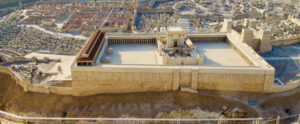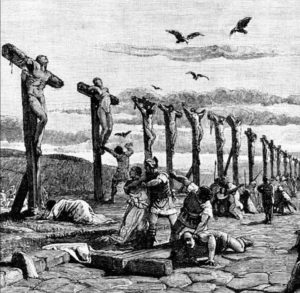Paradox of the Trial
 Possibly the greatest paradox in history occurred when Jesus of Nazareth was tried by Jewish magnates for the offense of blasphemy under God’s Law. The open question is whether or not Jesus was telling the truth…
Possibly the greatest paradox in history occurred when Jesus of Nazareth was tried by Jewish magnates for the offense of blasphemy under God’s Law. The open question is whether or not Jesus was telling the truth…
According to the Cambridge Dictionary, a definition of “paradox” is “a statement or situation that may be true but seems impossible or difficult to understand because it contains two opposite facts or characteristics.”[1]
Blasphemy is defined in God’s Law in Leviticus where the consequences of being guilty of the offense was the death penalty.[2] Jewish sages in a Talmud Mishna and Gemara written during the era of Jesus expounded that blasphemy is uttering the name of God and also may include cursing, piercing or incorrectly blessing His name.[3]
Once Jesus said “the Father is in Me, and I in the Father.”[4] On another occasion, Jesus said “…unless you believe that I AM, you’ll die in your sins.”[5] Practically every Hebrew knew that “I AM” is another name for God.
At the height of the trial, High Priest Caiaphas asked Jesus very specifically, “Are you the Messiah, the Son of the Blessed One?” Under oath Jesus answered, “I AM.”[6] Caiaphas immediately recognized the answer of Jesus and declared it to be blasphemy.
No doubt, Jesus believed and said he is the Son of God. As a result, Jesus of Nazareth was charged with blasphemy and found guilty by the Jewish leadership.
Previously, Jesus challenged people who didn’t believe he is the Son of God should, instead, believe in the miraculous deeds he performed. Nicodemus was one of those people who believed first in the miracles that Jesus performed.[7] The miracles; however, didn’t seem to matter to those judging Jesus.
Undercurrents of the aberrant trial were hugely significant. Promises made at Mt. Sinai two thousand years earlier had implications to the location and timing of the trial and crucifixion of Jesus. Those prophetic promises and their fulfillment laid the ironic groundwork for a paradox.[8]
Scroll back even farther to the book of Genesis during the time when Abraham had moved to a new land after leaving the Ur of the Chaldees with his father and family.[9] In that new land, Mt. Moriah became the place where Abraham took his miraculously born son, Isaac, to be sacrificed to God, then saved at the last moment.[10]
Centuries later, the Hebrews escaped the slavery of Egypt and arrived at Mt. Sinai where God handed down the Law to Moses. God also made promises about the place He had chosen for their future home. The place included Mt. Moriah.[11]
In the promised land of Abraham, a city called Salem had been already built. In the process of conquering enemies in the land of Abraham, Salem was overtaken by Israel’s army and came to be known as Jerusalem encompassing Mt. Moriah.
God promised a kingdom in the land of Abraham. It was established under King David and became the kingdom of Israel.
Another of those promises by God at the place was to provide “the permanent place for His Name to dwell.”[12] In a most unusual twist, King David offered an atonement sacrifice for a grave lack of faith in God. The location of the sacrifice happened to be a threshing floor on Mt. Moriah.
Fire came down from Heaven to burn the atonement sacrifice. King David was so moved by the circumstances surrounding the sacrifice, he chose that spot to be the location for the Temple, “the permanent place for His Name to dwell.”[13]
Matthew and Luke record that Jesus was in the Temple when he referred to Isaiah 56:7 saying “My House will be called a house of prayer.”[14] Jesus claimed the Temple as his house, the place where God’s name dwells, a statement with implications to the blasphemy trial.
God promised at Mt. Sinai that the most complicated cases in the land were to be litigated in the place He chose. Jerusalem became the place, the Judgement Seat of Israel.[15] Jesus was judged in that city by the Jewish leaders of the Sanhedrin.[16]
Sanhedrin, among other responsibilities, served as the supreme court of Israel. Sanhedrin membership consisted of priests, including the High Priest, and members of influential families.[17]
Priests of God themselves were charged with standing before God to serve as judges to honor and preserve the Law.[18] Indeed, even the High Priest Caiaphas was among those who judged Jesus in the Temple, the House where God’s Name dwells.[19]
Passover, since the deliverance from the 10th plague in Egypt, is stipulated by God to occur at an appointed time, Nisan (Abib) 15th. The observance date was codified in the Law at Mt. Sinai and God promised to provide the place to observe the Passover at its appointed time.[20] The Temple in Jerusalem became the only place to offer the Passover sacrifices.[21]
If Jesus is the Son of God, the trial and crucifixion became the ultimate, multifaceted paradox. Jesus was judged at God’s appointed time for the Passover; he was tried in God’s chosen Judgement Seat of Israel in God’s chosen holy city of Jerusalem; in the Temple where God’s name is to dwell; and the judges of the trial included God’s own top-level priests in defense of God’s own Law.[22]
Was the trial of Jesus a paradox – was Jesus the Son of God or a heretic?
Updated May 6, 2024
This work is licensed under a Creative Commons Attribution-NonCommercial-NoDerivatives 4.0 International License.
REFERENCES:
[1] “paradox.” Cambridge Dictionary. 2023. <https://dictionary.cambridge.org/dictionary/english/paradox> “The Paradox.” YouTube.com. image. 2015. <https://i.ytimg.com/vi/hRCedoRPyyo/maxresdefault.jpg>
[2] Exodus 22:28; Leviticus 24:15-16.
[3] Soncino Babylonian Talmud. Ed. Isidore Epstein. Sanhedrin 55b-56a. <https://israelect.com/Come-and-Hear/sanhedrin/sanhedrin_55.html>
[4] John 10:38.
[5] John 8:24. ISV.
[6] Mark 14:61. ISV, NLT, NRSV. CR Matthew 9:6, 26.64; Mark 2:10-11, 8:31, 14.62; Luke 5:24, 9:22, 22:69.
[7] John 3:1-2.
[8] “irony.” Cambridge Dictionary. 2023. <https://dictionary.cambridge.org/dictionary/english/irony>
[9] Genesis 11:31.
[10] Genesis 22:1.
[11] II Chronicles 3:1; II Samuel 5:6-11. Josephus. Antiquities. Book VII, Chapter III. Ryrie Study Bible. Ed. Ryrie Charles C. “Laws relating to conquests” ref. Ex. 23:20-33.
[12] Exodus 23; 29:43-46; 33; Deuteronomy 12:11-14, 16: 11,18-20, 17:8-10; Numbers 34:1-15; I Chronicles 17:3-10. CR Exodus 30:36, 40:2-11, 34-38; Leviticus 16:2; II Samuel 7:12-13.
[13] Deuteronomy 16:1,6. I Chronicles 21:18-26. CR Exodus 12:14-15; Leviticus 23:4-8. CR Deuteronomy 16:1-8; II Chronicles 8:12-14, chapter 29, 35:1-6.
[14] Matthew 21:13; Luke 19:46.
[15] Deuteronomy 17:8. CR Exodus 19:6.
[16] Ariel, Yisrael. “The Chamber of the Hewn Stone.” The Temple Institute. 2019. <https://www.templeinstitute.org/illustrated/hewn_stone_description.htm> Ariel. “Blueprints for the Holy Temple.” <http://www.templeinstitute.org/blueprints-for-the-holy-temple.htm>
[17] “Sanhedrin.” JewishEncyclopedia.com. 2011. <https://jewishencyclopedia.com/articles/13178-sanhedrin>
[18] Leviticus 19:15-18; Deuteronomy 1:16-17, 17:8-13, 19:15-21, 25:1. CR Exodus 18; 28:1; Numbers 8:14, Deuteronomy 16:18-19, 18:1-6, 21:5; II Chronicles 8:14; 19:8-11; Nehemiah 11:10-18. “Priest.” Jewish Encyclopedia. 2011.. <https://jewishencyclopedia.com/articles/12358-priest>
[19] “Sanhedrin.” JewishEncyclopedia.com. 2007. <https://www.jewishencyclopedia.com/articles/13178-sanhedrin> Schoenberg, Shira. JewishVirtualLibrary.org. “Ancient Jewish History: The Sanhedrin.” n.d. <https://www.jewishvirtuallibrary.org/the-sanhedrin> Shurpin, Yehuda. Chadad.org. “The Sanhedrin: The Jewish Court System.” n.d. <https://www.chabad.org/library/article_cdo/aid/4100306/jewish/The-Sanhedrin-The-Jewish-Court-System.htm>
[20] Exodus 12:14-15; Leviticus 23:4-8. CR Deuteronomy 16:1-8.
[21] Deuteronomy 16:1-6. II Chronicles chapters 8, 29, 34-35:19; Ezra 6:16-22. CR Leviticus 23:4-6; Numbers 9:2, 28:16-17. Edersheim, Alfred. The Temple – Its Ministry and Services. 1826 -1889. <https://ccel.org/ccel/edersheim/temple/temple.i.html> Coulter, Fred R. cbcg.org. The Christian Passover. “Chapters 12-13, Part 1. n.d. <https://www.cbcg.org/booklets/the-christian-passover/chapter-twelve-when-and-why-the-temple-sacrifice-of-the-passover-was-instituted-part-one.html>
[22] Exodus 26:31-37. Deuteronomy 12:11-14, 16:18-20; 17:8-10; 18:1-8, 19:15-18.


